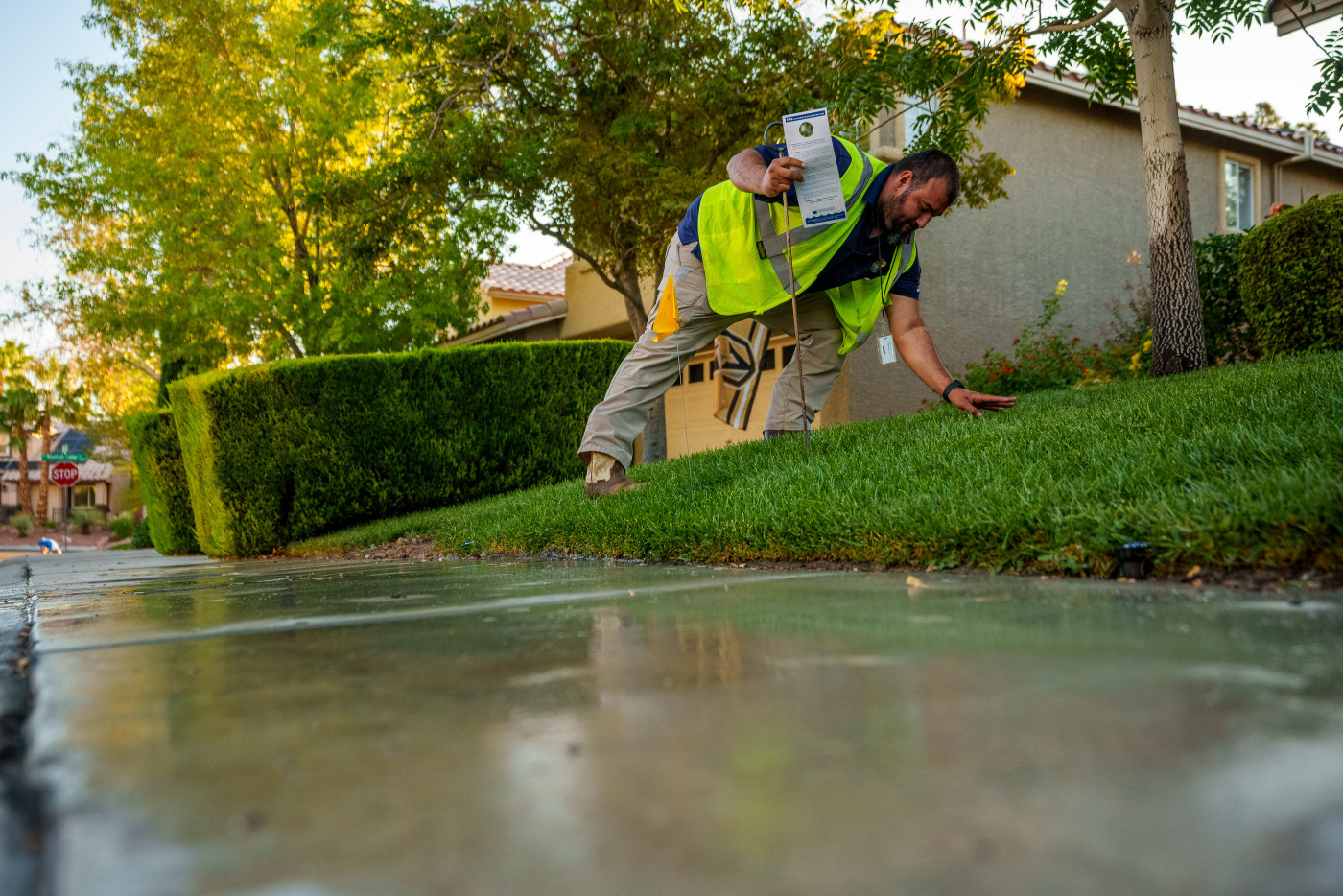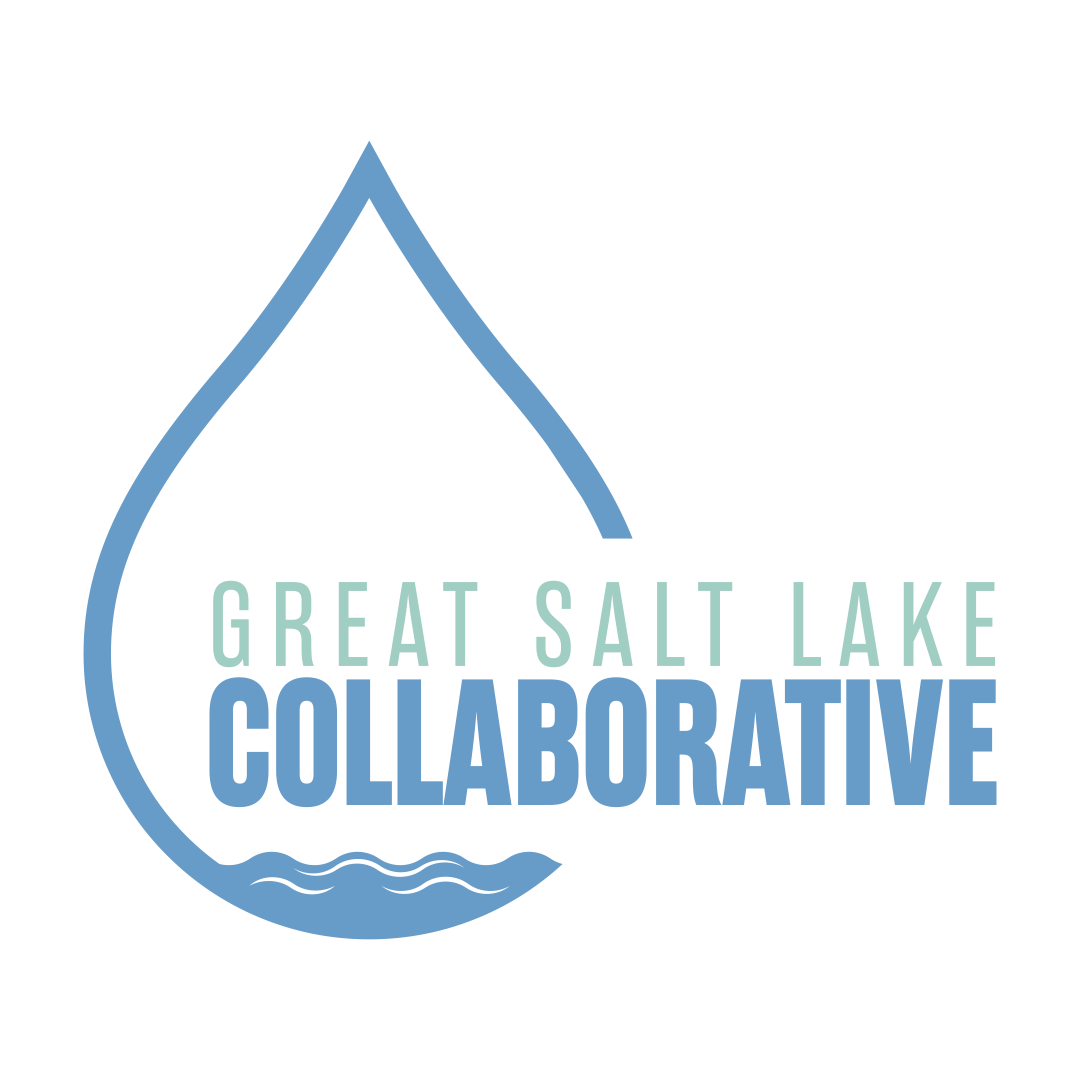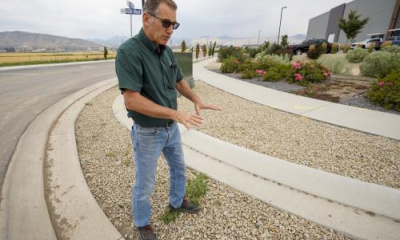SUMMERLIN, Nevada — The side of Salvador Polanco Gamez’s SUV reads “to protect and conserve.”
Bright yellow lights atop his vehicle are flashing as he drives through neighborhoods in this Las Vegas suburb, looking for water wasters. It doesn’t take long, just a couple of turns down some streets and he stops in front of a home.
Gamez pulls out his phone and starts recording the sprinklers pouring water into the gutter.
“It’s starting to cause some runoff,” Gamez said.
Listen to a radio version of this story
Gamez is a “water waste investigator” for the Las Vegas Valley Water District. It’s a government job where they are tasked with finding and enforcing violations of water waste under Nevada’s strict conservation laws.
Those strict laws regulating water waste are working — southern Nevada recorded a 26% drop in water use since 2002 — and could become one possible path forward for Utah's own efforts to save water and preserve the Great Salt Lake.
Gamez and his fellow investigators are part of that water-saving success. “We look for water waste which is prohibited in southern Nevada,” he said. “Coming off the property, leaks … and violations.”
Technically, any water that hits a gutter is considered “wasted.” The Southern Nevada Water Authority has mandatory restrictions on time of day, day of week and length of watering. Outdoor watering is limited to three days a week in the fall and the winter schedule is only one day a week. It goes back up in the spring starting March 1 to three days and during the summer months, water is permitted six days a week beginning May 1, but not between 11 a.m. to 7 p.m, the hottest times. Watering is never permitted on Sunday.
“Every day there’s water waste…,” Gamez said. “We’re trying to get it to completely stop. We’re doing every effort we possibly can.”
Gamez documented some water waste from Guido Huizing’s front yard. A small amount of water was running into the street from his sprinkler system.
“It's called runoff and as you can tell the grade of the property, I can’t control runoff,” Huizing said. “I’m within my four-minute cycle from the sprinklers.”
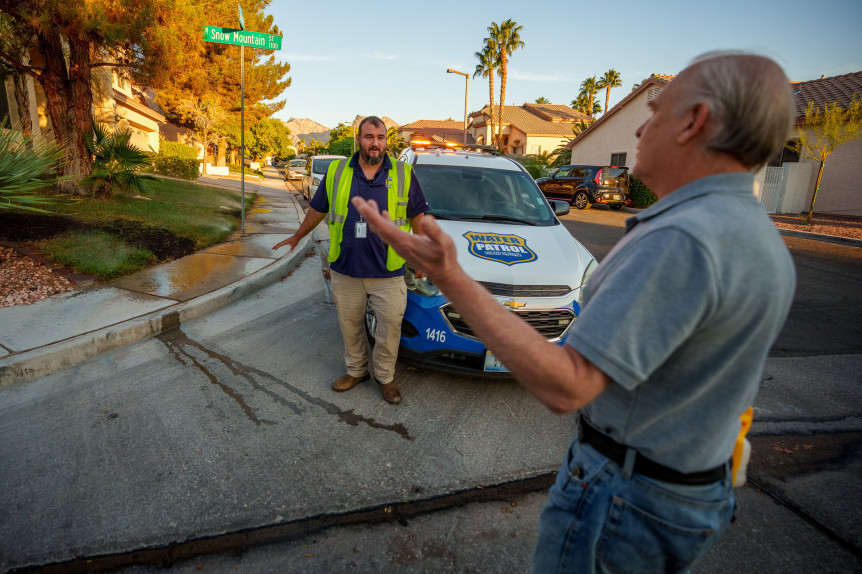
(Trent Nelson | The Salt Lake Tribune) Homeowner Guido Huizing, right, speaks with Salvador Polanco-Gamez, a conservation aide with the Las Vegas Valley Water District, on patrol in Summerlin, a community in the Las Vegas Valley, Nevada on Thursday, Sept. 29, 2022. When runoff water from a home's sprinklers reaches the street, Polanco-Gamez stops to document the situation and notify the homeowner.
At first, Huizing tried to argue over the violation. He said his HOA has certain demands and the grade of his property makes it difficult to maintain. But when asked about Nevada’s outdoor watering restrictions, Huizing said he is supportive.
“I can see the advantage to it. I’ve seen Lake Mead from when I first moved here 10 years ago to now, to the levels it’s at now. I understand it,” he said. “I really think the government needs to stop housing construction and stop the influx until they can discover a plan to what they’re going to do with the water situation. Until that happens, people shower every day, they flush toilets every day.”
Huizing did not get a citation. Instead, he was told to just adjust his sprinklers to prevent future runoff. Gamez said the majority of his work is educational, where he hangs a pamphlet on the door informing a homeowner that water waste was observed. The address is documented for any follow up or repeat violations.
“Some people don’t know,” Gamez said. Along with the door hangers, they are sent letters informing them of the observed water waste. ”Investigators do come out there and recommend some changes. It could be run times, it could be like sprinkler heads, low-flow sprays, things of that nature,” Gamez said.
Repeat violators get citations that range from $80 to $5,000 for the most egregious offenses.
The Las Vegas area has some of the nation’s toughest conservation orders because there simply isn’t the water to spare in this desert oasis. Roughly 90% of Nevada’s water comes from the declining Colorado River (and even then Nevada is entitled to only 1.8% of the river).
John Entsminger, general manager for the Southern Nevada Water Authority, said they have had to adapt.
“We prohibited installation of lawns in front yards. We limited landscapable area in backyards to 50%, we’ve had watering restrictions by day of week, time of day, by seasons,” he said. “And recently we’ve gotten more aggressive and banned nonfunctional turf and prohibited the installation of new turf except for schools, parks and cemeteries, limited pool sizes and pretty soon we’re going to have an excess use charge.”
The water authority’s conservation measures include:
- Grass banned from front yards since 2003
- Grass completely banned from new-home construction since April 2022
- All nonfunctional grass ordered removed from traffic medians, traffic circles, etc., by the end of 2026
- Residential pools limited to 600 square feet
- Golf course annual "water budgets" allow 6.3 acre feet per irrigated acre, reducing to 4 acre feet in 2024
When it comes to water use in southern Nevada, it’s common to point to the excess of the Las Vegas Strip as a prime example of waste. But Entsminger said it’s a misconception.
“The number one use of water in southern Nevada is single-family-residential homes,” he said. “People look at the Bellagio and think that’s the poster child. But actually, the resort industry in southern Nevada uses one-10th of 1% of all the water that’s available in the state of Nevada. In return for that, we get 25% of our direct employment.”
The casino resorts recycle so much of their water, it doesn’t have a significant impact. More than 60% of the Las Vegas area’s water use is residential, both indoor and outdoor. The area doesn’t really have an agricultural demand on water.
The Southern Nevada Water Authority recycles about 99% of its indoor water. Once it is processed, it’s put into a newly built wash, a project that cost $97 million. It is a 12-mile-long “urban” river that also doubles as a wildland habitat on the outskirts of Las Vegas. Ultimately, it flows downstream into Lake Mead, where it is used again.
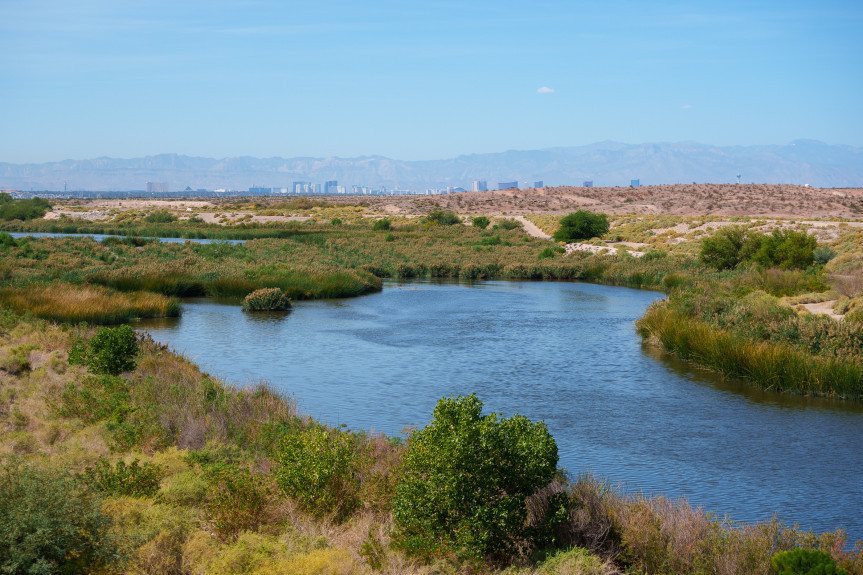
(Trent Nelson | The Salt Lake Tribune) Las Vegas Wash, a 12-mile-long channel that feeds treated water to Lake Mead, on Thursday, Sept. 29, 2022.
“It’s created by all the water that we treat and put back into the lake, we convey down the Las Vegas Wash and it’s become a world-class habitat for numerous aquatic species, numerous avian species, migratory birds. It serves the dual function of providing habitat for all those animal species but it also helps to clean the water as we put it back into the lake,” Entsminger said.
The Las Vegas area didn’t always have these restrictions. Going back two decades, lush green lawns were everywhere and water was more plentiful. But residents have watched as Lake Mead has declined. The “bathtub rings” show the impact of drought and climate change on the area. Boat ramps have closed. Signs show the water level by year, looking almost like a graveyard.
“They can see Lake Mead. They can see that 170-foot decline over the last 20 years and they know they have to do their part,” Entsminger said.
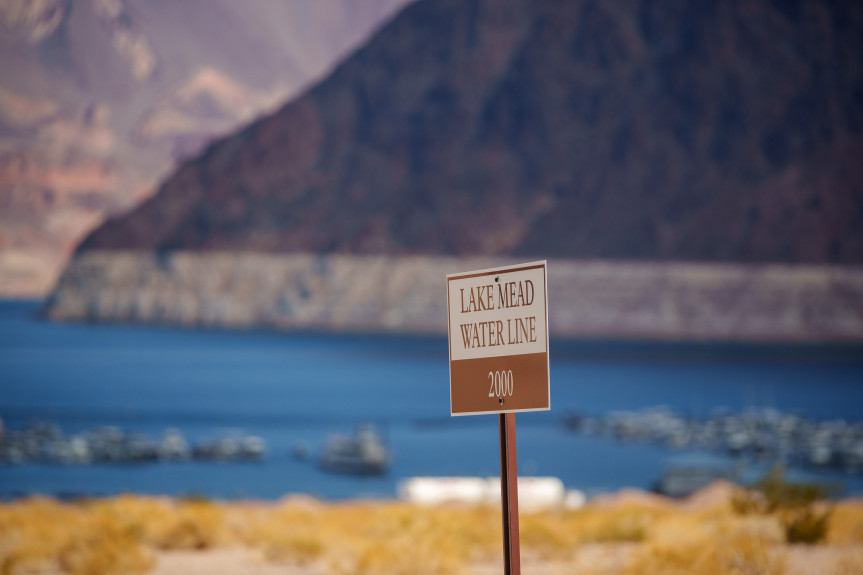
(Trent Nelson | The Salt Lake Tribune) A sign at the Hemenway Harbor launch ramp marks the water line at Lake Mead in 2000, contrasting with the current low water levels in Nevada, on Thursday, Sept. 29, 2022.
Data collected by the Southern Nevada Water Authority show residents are doing much better at conserving. The agency reports more than 26 billion gallons were saved since 2002 — a 26% drop in water use while 750,000 people to the Las Vegas area at the same time.
Entsminger said Nevada has had to impose restrictions because it needs to ensure a safe and reliable water supply. More than 70% of Nevada’s population is in southern Nevada.
To continue to ensure water for its residents, the Southern Nevada Water Authority built a series of pumps at Lake Mead that dip lower than others that have since gone dry. It was designed to be a $650 million “insurance policy” for a water crisis. In April, the water authority cashed in that policy.
“What that gives us is the ability to access Lake Mead even in a circumstance where the Bureau of Reclamation can’t physically release water through Hoover Dam and deliver that water downstream for California, Arizona and Mexico,” Entsminger said.
The pumps are located near Hoover Dam, in an area that used to be a popular spot for jet skis. It dried up and is now just desert. But Entsminger said it guarantees 2.3 million Nevadans have water — even if the federal government can’t deliver water downstream for 25 million others.
Upstream, Lake Powell has declined to the point where the federal government is concerned it can’t generate power for numerous states. Emergency releases of water from Flaming Gorge have been authorized. States have also had their shares of Colorado River water cut.
Nevada Gov. Steve Sisolak said he believes the current climate situation in the western U.S. is not so much a drought as "the new normal."
In a brief interview at an event where he was unveiling new infrastructure plans, Sisolak indicated Nevada’s tough restrictions could be an example for other states facing a water crisis including Utah and its rapidly declining Great Salt Lake.
"I do believe all states should look at what we did here. We’re recycling, reclaiming, reusing all our water that’s used indoors, at least 99% of it. We’ve removed nonfunctional turf,” he said. “We’ve put other things in place to try to preserve more water. I think we’ve set the bar pretty high.”

(Trent Nelson | The Salt Lake Tribune) Nevada governor Steve Sisolak in Las Vegas on Friday, Sept. 30, 2022.
Entsminger said further conservation will be needed to ensure a water supply for the Las Vegas area.
“Conservation is a journey. It’s not a destination. And we’re continuing on our journey. We’re sitting at about 110 gallons per capita per day in 2022. By 2035, we want to get to 86 gallons per day,” he said.
If they can get to that 86 gallons per person per day, Entsminger said it would ease his concern about having a reliable water supply.
“With the infrastructure we’ve installed, I believe southern Nevada is the most water-secure urban area that uses Colorado River water,” he said.
Back in Summerlin, Huizing said he is looking into getting information from the Southern Nevada Water Authority about rebates they offer if he gets rid of his lawn. Asked if other states, like Utah, should be as tough on outdoor watering, he replied: “Yeah I think the aligning states along the Colorado River corridor need to do as much as we are, if not more than we are because they seem to be less restrictive than we are.”
What's your response to Solutions found for GSL in Sin City?
Does this reporting project make you feel hopeful? Concerned? Inspired? Surprised?
Selected responses will be used on social media, on our website or in our newsletter.

